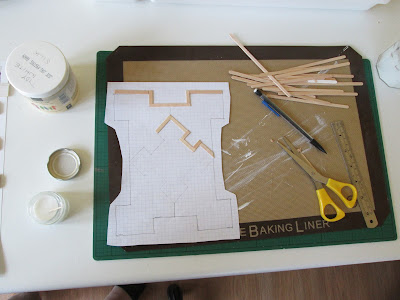So, meanwhile, I pondered how to pretty up the music room without it getting too decorative - bit of a contradiction. I have ended up with a very plain room - just as in my real life. On the one hand I validate it by saying this is how I would live there and that Elizabeth is my alter ego in my dream life so why not follow that path; then, on the other hand, making minis is a way to escape your real life and real self and do something else.
Back to the overly plain room.... how about a decorative ceiling. I did lots of gandering around the web looking at Georgian/Regency/Adam ceilings and, boy, were they over the top. Very beautiful but not what I was looking for. So, starting with a memory of some laser work I had seen somewhere and the idea of keeping it angular (to go with the dental trim) I doodled around on some graph paper.
 |
| thoughts become concrete |
How to make it (?) not sure cardboard would work, lets try coffee stirrers....
 |
| made more concrete |
 |
| spot the missing bit |
In this room I would need two of these to define each area. The room is a combined original room plus a space that was once divided off for a staircase. The position of the windows make my larger room sort of offset still with a larger and smaller portion. It works fine and rooms were often like this. The main part of the room will divide again into two as there will be two ceiling lights, one either side of the ireplace. I measured and fiddled the paper and stirrers up on to the ceiling along with a light and tried to imagine another to the right of it. My plain brain screamed, " Too fussy, too fussy"
 |
| Do I like you? |
 |
So, I wandered around the house.... no use in the dining room or sitting room unless I put one in each as the rooms are - one on the left of the hall and one on the right of the hall and it sorts of knocks them off symmetry. That left the hall.........
 |
| winky-wonky |
It is a bit winky-wonky and either the light is off centre, or my home made 'plaster-work' leaves something to be desired as it won't quite centre itself nicely. It has set me off wanting one (or two) proper ones though for somewhere.
--------------------------------------------------------------------------------------------------------------------------------------------
--------------------------------------------------------------------------------------------------------------------------------------------
Hey Presto - ordered from Dolls House Direct. Now the big debates begin.....
.......small set diagonally, small set square on, two pairs in music room for each light in there, one in dining room and one in sitting room, one in the hall and none in the other rooms, none at all..... see how my poor festering brain dashes around getting no where.
Then spent ages deciding on best place for them
I balanced the lights where they would go, took a photo and spun the photo upside down so I could get an idea of what they would look like suspended....... OK that was eleven squid wasted - just don't like the idea any more - find it too fussy for a room I intend to keep sparse for paintings and they drown the puny lights. (ceiling too low for grand lights)
(18/5/17)
.......small set diagonally, small set square on, two pairs in music room for each light in there, one in dining room and one in sitting room, one in the hall and none in the other rooms, none at all..... see how my poor festering brain dashes around getting no where.
First I made a template of the ceiling using a wallpaper sample
Then spent ages deciding on best place for them
I balanced the lights where they would go, took a photo and spun the photo upside down so I could get an idea of what they would look like suspended....... OK that was eleven squid wasted - just don't like the idea any more - find it too fussy for a room I intend to keep sparse for paintings and they drown the puny lights. (ceiling too low for grand lights)
(18/5/17)














































